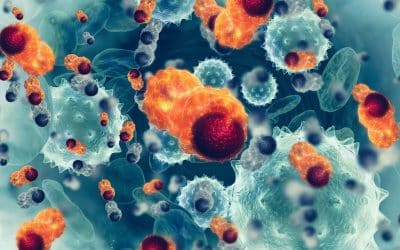Circulating endothelial cells in cancer
Vascularization, a hallmark of tumorigenesis, is classically thought to occur exclusively through angiogenesis. However, there is a growing body of evidence that endothelial progenitor cells and proangiogenic hematopoietic cells are able to support the vascularization of tumors and may therefore play a synergistic role with angiogenesis. An additional cell type being studied in the field of tumor vascularization is the circulating endothelial cell (CEC), whose presence in elevated numbers reflects vascular injury. Levels of CECs are reported to correlate with tumor stage and have been evaluated as biomarkers of the efficacy of anticancer/antiangiogenic treatments.
This blog starts with a summary of circulating endothelial cells’ phenotypes and enumeration strategies. We then discuss the clinical significance of CEC in cancer diagnosis and therapy monitoring. This episode provides an update on the biology of CECs and explores the utility of these cell populations for clinical oncology.
Introduction
CECs have been described as early as the 1970s (Woywodt et al., 2002; Lin et al., 2000) as products of vascular shedding that correlate with disease severity in conditions like myocardial infarction, malignancy, and vasculitis (Segal et al., 2002; Blann et al., 2005; Mancuso et al., 2001; Zhang, 2022; Parfenova et al, 2010). Their relative quantities are used as markers of disease progression and their elevation implies a central role of vascular injury in the progression of the disease of interest (Giordano et al., 2022). Although CECs were first described over 50 years ago through methods such as vital light microscopy, May–Grünwald–Giemsa staining, and separation by Ficoll density centrifugation (Hladovecz, 1978; Wright and Giacometti, 1972) the development of specific monoclonal antibodies has only recently provided an opportunity to investigate the pathophysiology of these cells. In 1991, monoclonal antibodies to two novel EC-specific surface antigens (HEC19 (Sbarbati et al., 1991) and S-Endo-1 (George et al., 1992) later described as CD146 (Bardin et al., 1996)) were developed and used to quantify CECs. More recently, these authors and others have used the immunobead technique and/or flow cytometry to investigate the significance of CECs in a variety of diseases including infections, cardiovascular, inflammatory, and autoimmune syndromes, and cancer (reviewed in (Dome et al., 2009)
Characterization and enumeration of circulating endothelial cells
Generally, the main technical problem in clinical studies quantifying CECs is their sparsity in peripheral blood (PB). Different techniques of cell enrichment and immunocytochemical detection have been applied to quantify these rare cells, such as density centrifugation methods, cell culture, and immunomagnetic separation. The latter technique, developed by George et al., includes mixing PB with immunomagnetic beads coated with anti-CD146 antibodies, which then bind to CD146-expressing CECs and are selected by magnet retrieval (George et al., 1993). However, although it is most frequently used for CEC enumeration, CD146 expression has also been reported in pericytes, bone marrow fibroblasts, cancer cells, trophoblasts, and activated lymphocytes; thus, caution in interpreting results with CD146 alone is advised (Khan et al., 2005; Goon et al., 2005). Nevertheless, unspecific CD146 expression should not necessarily be considered a technical limitation in the detection of CECs, since CD146-based immunomagnetic separation has been adapted to cope with it. Immunomagnetic separation is best accompanied by an additional specific characterization step, such as Ulex Europaeus lectin-1 (UEA-1), CD31, or von Willebrand factor (vWf) labeling to confirm that all sorted cells are CECs. This methodology has been used successfully in a large number of studies showing altered CEC levels in various diseases. Accordingly, the authors of a multicentric study defined CECs as cells that exceed 10 μm in size and have more than five immunomagnetic beads attached. The rosette cells stain positive with at least two EC markers (for example, CD146 and UEA-1) and are negative for leukocyte markers (for example, CD14 and CD45) (Woywodt et al., 2004). A widespread alternative to the immunomagnetic separation technique is flow cytometry, during which the whole PB is usually labeled with endothelial-specific antibodies conjugated with different fluorochromes. An advantage of flow cytometry is the rapid multiparametric analysis and the ability to detect subpopulations, such as “bright” versus “dim” labeling, and activated (e.g. expressing CD106) or resting, although CECs separated by the immunomagnetic method can also be multiply labeled. For example, Duda et al. have reported a cytometry protocol for phenotypic identification and quantification of CECs in human PB. Using four surface markers (CD31, CD34, CD133, and CD45) and multicolor flow cytometry, their group has proposed a surface phenotype of viable CECs (defined as CD31brightCD34+CD45−CD133− cells) (Duda et al., 2007). However, there are substantial differences between immunomagnetic separation and flow cytometric techniques, as indicated by the high variation in reported CEC numbers. Based on CD31bright/CD45− staining, the number of cells recorded per milliliter of PB is about 1000- to 100,000-fold higher than the number of CECs reported in healthy controls and different categories of patients using CD146-based immunomagnetic separation. The results of Strijbos et al. may, in part, explain the significantly higher CD146+ CEC levels as reported using the single platform flow cytometric assay and those determined by CD146-based immunomagnetic separation techniques (Strijbos et al., 2007). In light of these results, CEC enumeration is far from being a standardized procedure and the confusion in CEC numbers does raise serious questions concerning the reliability of the above techniques. Because there are no studies currently available demonstrating the superiority of one technique over the other, more research is required to measure/correlate the accuracy of the above methods.
Circulating endothelial cells in cancer
Elevated levels of CECs have been repeatedly found in different types of human malignancies. This observation first appeared in the literature in 2001 when Mancuso et al., using 4-color flow cytometry, found that in breast cancer and lymphoma patients, both resting and activated CECs were increased significantly (Manusco et al., 2001). In addition, CEC levels were similar to healthy controls in lymphoma patients achieving complete remission after chemotherapy, and activated CECs were found to decrease in breast cancer patients evaluated after surgery. Although they employed different methods of assessing CEC levels and disease stage, Beerepoot et al. also reported a significant CEC elevation in cancer patients with progressive disease, whereas their patients with stable disease had CEC levels comparable to those of healthy individuals (Beerepot et al., 2004). Subsequent studies yielded similar results. Zhang et al. investigated CECs in multiple myeloma, demonstrating increased numbers of these cells compared to healthy controls(p<0.001) (Zhang et al., 2005). Wierzbowska et al. evaluated CEC levels by 4-color flow cytometry in acute myeloid leukemia (AML) and reported elevated numbers of both resting and activated CECs (Wierzbowska et al., 2005). In their study, CEC levels were correlated with disease status and response to treatment as well. In another study on breast cancer, CECs were found to be significantly elevated in cancer patients and decreased during chemotherapy (Fürstenberger et al., 2006). Rowand et al. observed that CEC counts were significantly higher in metastatic breast, colorectal, lung, prostate, and ovarian carcinoma patients compared to healthy controls (Rowand et al., 2007). Similarly, increased CEC levels have been reported in the PB of patients with gastrointestinal stromal tumors (Norden-Zfoni et al., 2007), myelodysplastic syndrome (Della Porta et al., 2008), and chronic lymphocytic leukemia (Go et al., 2008). In a complex comparative study where circulating tumor cell (CTC) and CEC numbers were measured parallel, the authors concluded that CEC is of stronger prognostic value than CTC in metastatic colorectal cancer (mCRC). CEC numbers are an independent prognostic factor in mCRC and as such may be superior to CTC. CEC may thus serve as a valuable addendum to the currently available panel of prognostic markers in mCRC (Rahbari et al., 2017). Ma and colleagues analyzed the CEC number in neoadjuvant-treated breast cancer patients. Aneuploid CECs in the peripheral blood showed a biphasic response during NCT, as they initially increased and then decreased, whereas a strong positive correlation was observed between aneuploid CECs and CTC numbers. They determined that aneuploid CEC dynamics vary in patients with different responses to chemotherapy. Elucidating the potential cross-talk between CTCs and aneuploid CECs may help characterize the process associated with the development of chemotherapy resistance and metastasis (Ma et al., 2020). Taken together, it is apparent that CECs are increased in patients with different types of malignancies. Furthermore, there is a growing body of evidence that this cell population may evolve into a surrogate biomarker for measuring the effectiveness of conventional and targeted (antiangiogenic) anticancer therapy. What is less clear is whether or not CECs are simply biomarkers of the accelerated endothelial turnover of tumor capillaries or are active participants of tumor progression and vascularization. However, it is also possible that CECs are not being exfoliated from activated tumor vasculature. Instead, their increased number in the PB may be the result of a more generalized systemic endothelial damage and/or activation.
Conclusion
Solid tumors are critically dependent on angiogenesis to exceed a size of 2-3 mm3 (Hanahan and Weinberg, 2000; Hanahan and Weinberg, 2011). In addition to vascular injury, which regularly occurs in all solid tumors and may be a result of exaggerated angiogenesis, all modes of tumor angiogenesis induce the shedding of cells of endothelial origin into the circulation. These circulating endothelial cells (CEC) may therefore be used as a surrogate marker for the tumor’s angiogenic activity as well as the degree of vascular injury.
Recent blogs
A New Era in Liver Cancer Detection: The Promise of HepaAiQ
In this blog entry, we will explore the recent history, intriguing findings, and tools related to cfDNA fragmentomics.
Cell-free DNA Fragmentomics: A Promising Predictor of Cancer
In this blog entry, we will explore the recent history, intriguing findings, and tools related to cfDNA fragmentomics.
New developments in the field of circulating tumor cells (2024)
The blog post focuses on how researchers can produce more meaningful, applicable results that directly benefit human health.




